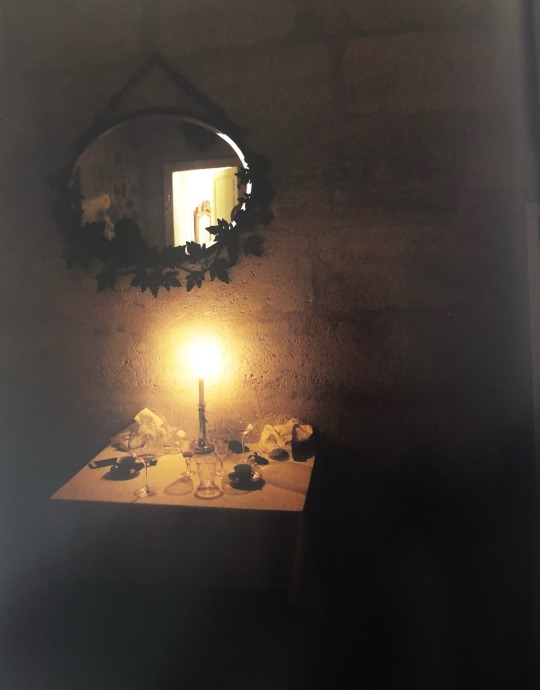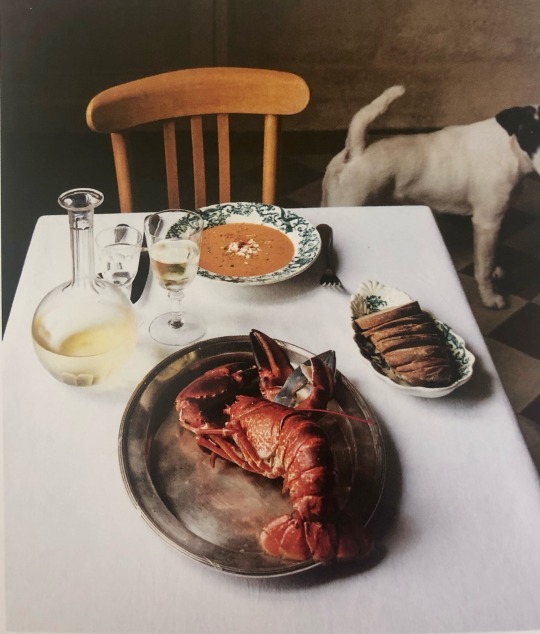#oddurs...
Explore tagged Tumblr posts
Text

At Home in France with the Food Writer Mimi Thorisson
For the food writer Mimi Thorisson, a lot goes on at home - a nineteenth-century house in the Médoc, which she shares with her photographer husband Oddur, seven children and nine dogs.
#france#french country#french#countryside#food writer#mimi thorisson#tablesetting#dinner#family meal#aixenprovence
11 notes
·
View notes
Text
youtube
Authorities in Iceland say lava from a volcano that erupted early on Sunday appears to have eased. The flow of molten rock destroyed several homes in the small fishing town of Grindavik, as well as its electricity and hot water supply. Excavators have been clearing the main road after lava flowed over it. The town was evacuated on Saturday so there is no immediate danger to life. Grindavik is around 40 kilometres southwest of the capital Reykjavik. For more on this, we talk to Oddur Thordarson, who reports for the Icelandic National Broadcaster RUV News.
2 notes
·
View notes
Text
0 notes
Text

Subglacial Gjalp eruption in 1996.
(Oddur Sigurdsson, Iceland Geological Survey, CC BY)
0 notes
Text
0 notes
Video
vimeo
Oddur Roth | Painting with Objects from Olly Bharat on Vimeo.
0 notes
Text
Müxtəlif alimlər eşqə fərqli təriflər veriblər. Bəziləri eşqi yanan oda, bəziləri isə işıq saçan nura bənzədiblər. Eşq oddur, çünki məşuqdan savayı hər şeyi insanın gözündə yandırıb, təkcə məşuqu saxlayır. Eşq nurdur, çünki işıq saçaraq məşuqun mənzilini göstərir. Lakin bu sözlərin heç biri eşqin həqiqi tərifi deyil. Eşqin nə olduğunu yalnız onu yaşayanlar anlaya bilər.♡
Eşq kitablarda olsa, nə vardı. Eşqi kitablardan öyrənə bilməzsən, sətirlərə yerləşməyəcək qədər bal əzabıdır. Gəl sənə eşqdən danışım. Əvvəlcə kitabları yandır. Eşqi aşiqlərdə axtarma. Eşq aşiqin güzgüsü deyildir, buna görə kor bazarında güzgü satılmaz. Eşq kəlmə deyil ki, dəftərə yazasan, eşq paraqrafları talan edər. Eşqin kitablara yerləşməməsinə səbəb budur. Kitab şərh, yozum işidir, eşq şərhlərlə, yozumlarla yolunu yormaz. Eşqin özü ucu-bucağı görünməyən yoldur. Yolun çuxurundan, palçığından şikayətlənmə. Eşq palçığı nurlandırandır. Unutma! Sən ruh deyilən nur ilə palçıq deyilən bədənin birləşməsindən yarandın...
38 notes
·
View notes
Text




Credit: Oddur Thorisson
24 notes
·
View notes
Audio
Cryptid by Legend from the album Midnight Champion
#music#icelandic music#music of iceland#legend#artoffact#artoffact records#krummi bjorgvinsson#krummi björgvins#oddur hrafn stefán björgvinsson#krummi#halldór a. björnsson#halldór björnsson#halldór agúst björnsson
14 notes
·
View notes
Text


messy post but i thought itd be neater in images than dumping it outside a cut. but some masculine and feminine names since i didnt add any examples! left for both images is fem and right masc
First names
Feminine
Nónni
Veidi
Stornu
Gripári
Misti
Peri
Snöeinn
Línan
Skínn
Snöen
Péroan
Frostru
Haoúginn
Hersi
Gleikur
Láren
Ömaran
Borkur
Hómmi
Nagí
Núlfur
Dásinn
Sanjur
Ísan
Perkur
Reidi
Vrinövi
Runtur
Heimur
Pamo
Ingúri
Rikarí
Ruiginn
Niláinn
Merginn
Kálinn
Sólinn
Mungi
Jarni
Maukú
Stjinn
Lánetu
Berur
Linpu
Stíni
Framur
Magú
Keri
Reidu
Ördinn
Tóti
Masculine
Döuva
Lifio
Leafa
Vetur
Frosinn
Vébur
Míva
Hrenína
Stúrnuan
Eibor
Póra
Fía
Riveida
Vraínn
Strónen
Sgra
Hrasdó
Rödur
Gréppur
Keigo
Melgá
Rigninn
Snjören
Sársa
Brégtur
Söfa
Kovur
Mífa
Bóela
Ísaro
Valía
Trur
Sálmo
Doarubi
Mamur
Háka
Bjour
Veiga
Sigva
Síso
Fra
Hánno
Jávva
Ingira
Lemmá
Eplinn
Pera
Elpsa
Oddur
Leikur
Joná

some basic notes on names within the language Fríveidislen (from Fríveidouson)! ive additionally got a WIP perchance generator here
General name notes
[first name][last name] [middle name]
In legal documents, “of [town]” is additionally added to the end
Last names medium to long length wise, first names short to medium
Names are matrilineal
-slen denotes language or ethnicity; equivalent of -ish in Spanish, or -ian in Canadian; mean’s “God’s people”
-inn in names means “of God’s grace” and is used in first and last names
-ouson means “blessed by God” and is used for towns and such (potentially locations in general?)
-ur means “of God’s love” and is used in first names
-dir means “God’s right hand” and is used in last names
-örn means “God’s child” and is used in last names
-an means “a gift of God” and is used in first names
-en means “praise of God” and is used in first names
Name endings not meaning something are more modern;
-a is a masculine first name ending
-o is a masculine first name ending
-i is a feminine first name ending
-u is a feminine first name ending
3 notes
·
View notes
Link
The crowd held a memorial service for the glacier marked by poems and speeches.
“This monument is to acknowledge that we know what is happening and what needs to be done. Only you know if we did it,” read a memorial plaque put on the glacier.
The glacier used to cover six miles of ground and is the first of Iceland’s glaciers to disappear, AP reported. Sigurdsson said all Iceland’s glaciers will be gone within 200 years.
#funerals#glaciers#Daily Caller#Iceland#Okjokull#Oddur Sigurðsson#climate change#protests#activists#Mary Margaret Olohan
3 notes
·
View notes
Text
President Guðni Thorlacius Jóhannesson of Iceland visits MIT | MIT News
President Guðni Thorlacius Jóhannesson of Iceland visits MIT | MIT News
Guðni Thorlacius Jóhannesson, the president of Iceland, visited MIT on Friday, engaging in talks with several campus leaders and professors, and touring the Media Lab. Jóhannesson visited the Institute along with a substantial delegation of officials and scholars from Iceland. They met with MIT scholars, who delivered a variety of presentations on research, design, and entrepreneurship; the…
View On WordPress
#Elfar Adalsteinsson#Gilad Rosenzweig#Guðni Thorlacius Jóhannesson#Hashim Sarkis#Jónas Oddur Jónasson#Krystyn Van Vliet#Lilja Dögg Alfreðsdóttir#Nikulás Hannigan#Svafa Grönfeldt
0 notes
Note
When Elliott (Runes, 1959) says „in seventeenth-century Iceland people were still burnt because runes were found in their possession, and it was necessary officially to prohibit the use of runes in 1639“, do you know what he is referring to? His source is Arntz (Handbuch der Runenkunde, 1935, 2nd ed, 1944), as is Jones/Pennick‘s in History of Pagan Europe (only other place I found this mentioned so far).
I'm not sure. Best I could manage for finding it in Arntz was searching "1639" and "verbrennen"/"Verbrennung" in the Google Books preview, to no effect. According to Björn Jónsson á Skarðsá, Oddur Jónsson was whipped at the alþing for having papers/pages of "superstition" (hindurvitnis blöð) and the pages burnt, but he doesn't specify what was on them. The Icelandic Witchcraft museum says that those pages had runes on them but I don't know where they're getting that from or if it's interpretive, and in any case they certainly also had other things that were more explicitly forbidden so I don't think the presence of runes would tell us anything.
There was a strong association between illegal magic and runes at the time but as far as I know that has more to do with people who did or were suspected of doing magic also happened to be the ones who knew the most about runes. Mostly I'm talking about Jón lærði, specifically. It wouldn't be too surprising if bishops either thought of runes as the smoke indicating the fire of sorcery, or of banning runes as a way of preventing sorcery without them being sorcery themselves. When the same aforementioned Björn á Skarðsá wrote his essay on runes that survives in a bunch of manuscripts, he dedicated a whole chapter to explaining that no, runes are -- contrary to many people's belief -- actually not inherently evil. But it would surprise me if they managed to get them officially banned three years after Ole Worm published the first edition of Runir seu Danica literatura antiquissima, and more than a decade after Worm had started using Icelanders as informants about runes.
I don't think it's out of the question that some people may have banned or attempted to ban them within certain districts temporarily; I just am not turning up evidence for it. What I'm seeing more of is "These Icelanders said Jón lærði was using galdrastafir (=illegal), but the Danish officials determined they were just regular runes (=legal)."
Jón lærði complained about how nowadays (the mid-1600's) they prosecuted people over petty little harmless magic things, when in the good ol' days (the 1400's) you could get away with anything as long as you weren't causing harm to someone. If we're to take that seriously (as Einar G. Pétursson does in his edition of some works by Jón lærði, and points out that this makes sense with the coming of Protestantism) then the word "still" does not belong in the Elliott quotation. If there was concern about regular málrúnir, it was probably a new phenomenon.
Elliott could be pulling a bait-and-switch (or maybe Arntz is). Elliott is a serious scholar but heavily biased toward seeing runes as inherently, first-and-foremost magical. He might be allowing a failure of specificity to make one thing (["runes" = magic symbols] were banned) imply another thing ([málrúnir] were banned). If someone has access to the Arntz book it would be very helpful to see what he cites.
18 notes
·
View notes



